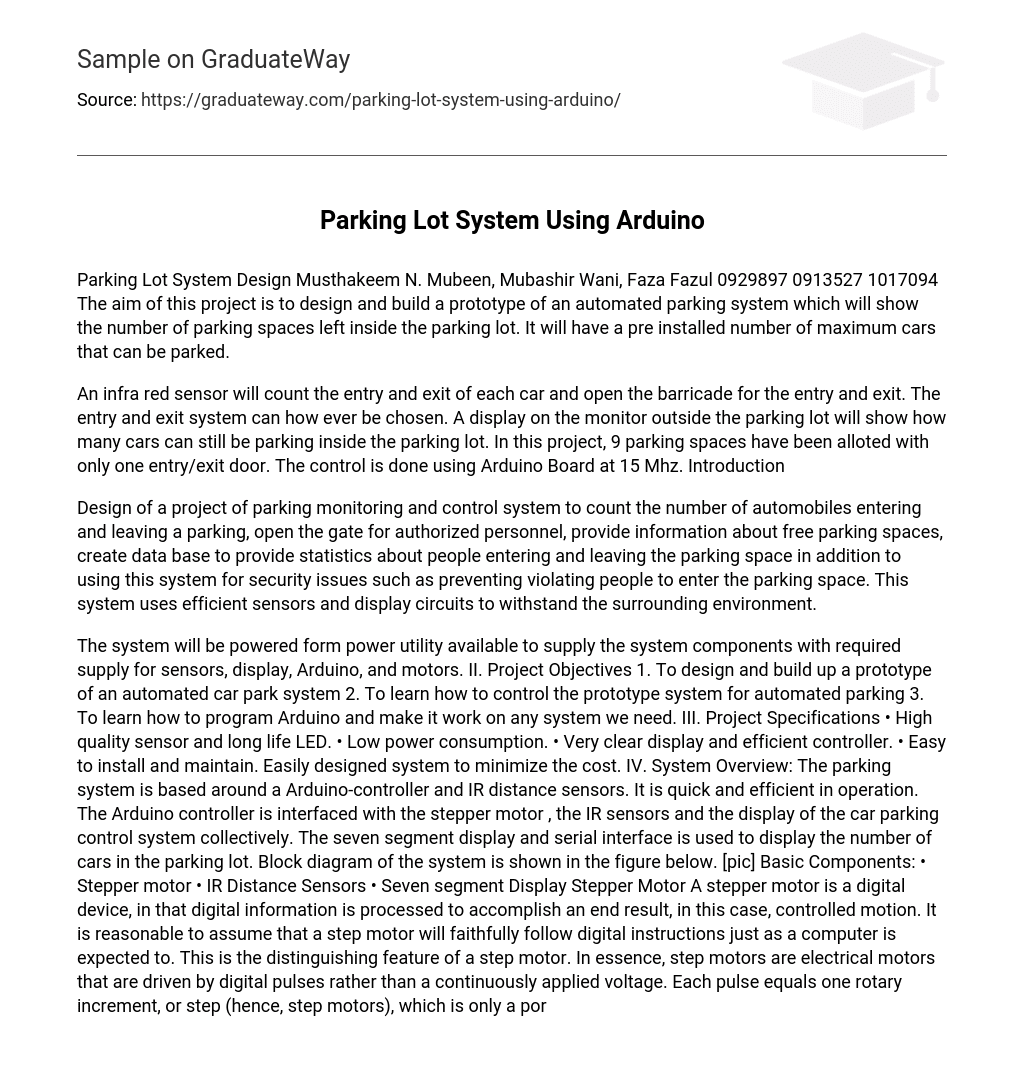Parking Lot System Design Musthakeem N. Mubeen, Mubashir Wani, Faza Fazul 0929897 0913527 1017094 The objective of this project is to create and construct a prototype for a parking system that is automated and displays the remaining number of parking spaces in the lot. It will have a predetermined maximum capacity for cars that can be parked.
The entry and exit of each car in the parking lot is counted by an infrared sensor, which also opens the barricade for entry and exit. The choice of the entry and exit system can be made accordingly. A display on the outside monitor of the parking lot will indicate the number of available parking spaces. This project includes 9 allocated parking spaces with a single entry/exit door. The control for this system is managed using an Arduino Board operating at 15 Mhz.
A project has been developed for monitoring and controlling parking, which tracks the number of vehicles entering and exiting a parking area. The system grants access to authorized personnel, provides information on available parking spots, and creates a database for statistical analysis of people entering and leaving the parking area. It can also serve security purposes by preventing unauthorized individuals from accessing the space. To ensure durability in various environments, the system integrates efficient sensors and display circuits.
The system will be powered by the power utility to supply components such as sensors, display, Arduino, and motors. The project objectives are to design and build a prototype of an automated car park system, learn how to control the prototype system for automated parking, and learn how to program Arduino for any system needed. The project specifications include high-quality sensors, long-life LED, low power consumption, clear display, efficient controller, easy installation and maintenance, and cost minimization. The system overview involves an Arduino-controller, IR distance sensors, a stepper motor, and a display for the car parking control system. The seven-segment display and serial interface are used to show the number of cars in the parking lot. The basic components include a stepper motor, IR distance sensors, and a seven-segment display. A stepper motor is a digital device that follows digital instructions like a computer.In simple terms, step motors operate using digital pulses instead of a constant voltage. Each pulse corresponds to a step, which is a fraction of a full rotation. This is why they are called step motors.
Sharp distance sensors, commonly used in projects requiring precise distance measurements, are a cost-effective alternative to sonar rangefinders and offer superior performance compared to other IR options. Interfacing with microcontrollers is simple as the single analog output can be connected to an analog-to-digital converter for distance measurement or a comparator for threshold detection.
The detection range of this version is approximately 10 cm to 80 cm (4″ to 32″). A plot of distance versus output voltage is shown below. The seven segment display, which consists of 7 LEDs combined into one case, is found in many electronic devices. The circuit connections are shown in the diagram above, indicating that the entry exit is linked to the 7 segment LED. With an Arduino, a simple system can be created.
The IR sensors were connected to the digital side of the Arduino board, which is programmed to give the desired output. The 7 segment LED and the servo motor are also connected to the Arduino board. The LED is initially set to number 9 when there are no cars in the parking lot. When a car enters, the IR sensor detects it, opens the barricade, and reduces the number on the LED to 8. This process continues until there are no more available parking lots.
When a car leaves, the LED number increases by 1. If there are no available spaces, the door will not open for a car trying to enter.
To enhance reliability, two additional factors should be included in future research. First, IR sensors need to be installed above each parking spot. These sensors can connect to an LED system that will direct cars to an unoccupied parking space. This will significantly save time for customers and increase their satisfaction.
VIII. CONCLUSION The parking system prototype has been completed. It can be easily adapted to a real model with minimal changes according to the specific requirements. This program can be utilized in multi-storey parking lots, where each floor can integrate this system for display. The Arduino programming code for the Car Parking system is provided below.
#include Servo myservo; // create servo object to control a servo #define ServoM 12 //Connected to the servo motor.
#define Bright 11 //servo library disable PWM on pins 9 and 10.
#define Exit 9 //Pin connected to the EXIT button.
#define In 8 //Pin connected to the IN button.
#define BarLow 177 //Low position of the barrier.
#define BarUp 95 //Up position of the barrier.
#define CAPACITY 8 //Capacity of the parking lot.
#define INTEN 80 //Display intensity %
//Pins conections to segments (cathodes).
#define segA 0
#define segB 1
#define segC 2
#define segD 3
#define segE 4
#define segF 5
#define segG 6
//Array with the segments to represent the decimal numbers (0-9).
byte segments[10] = { // pgfedcba





